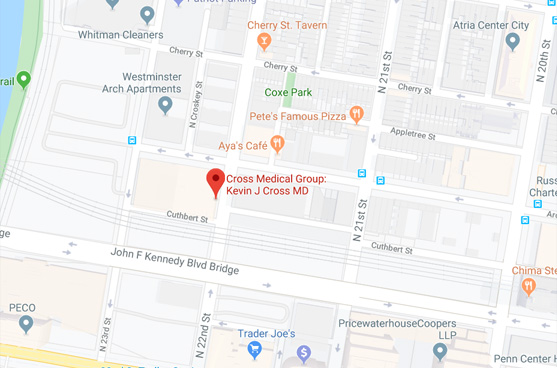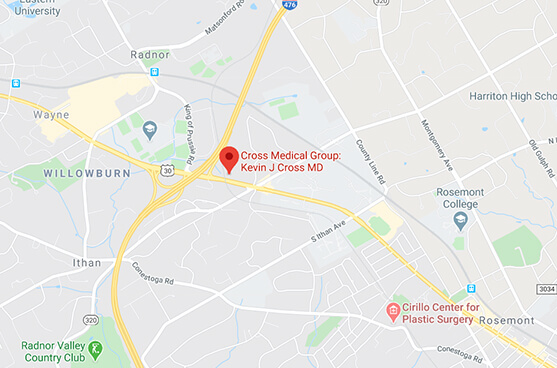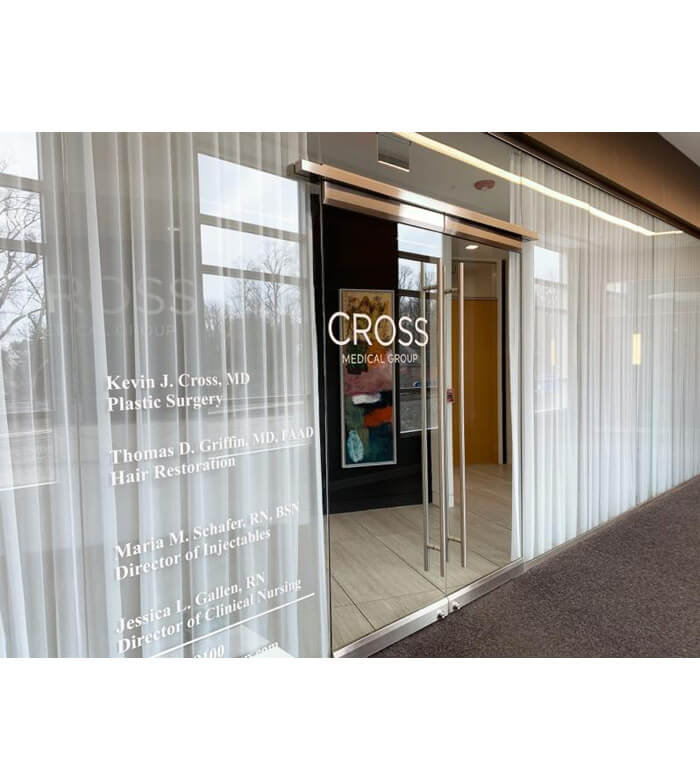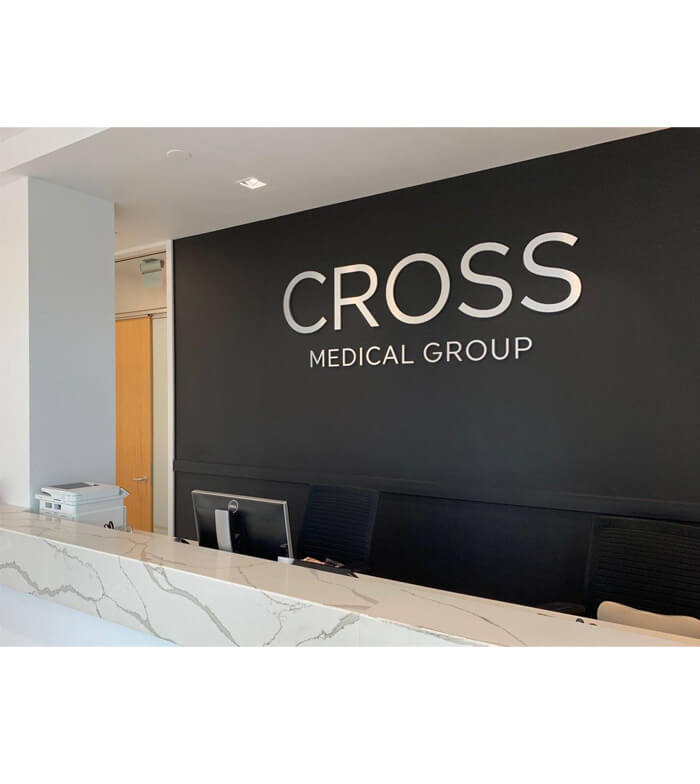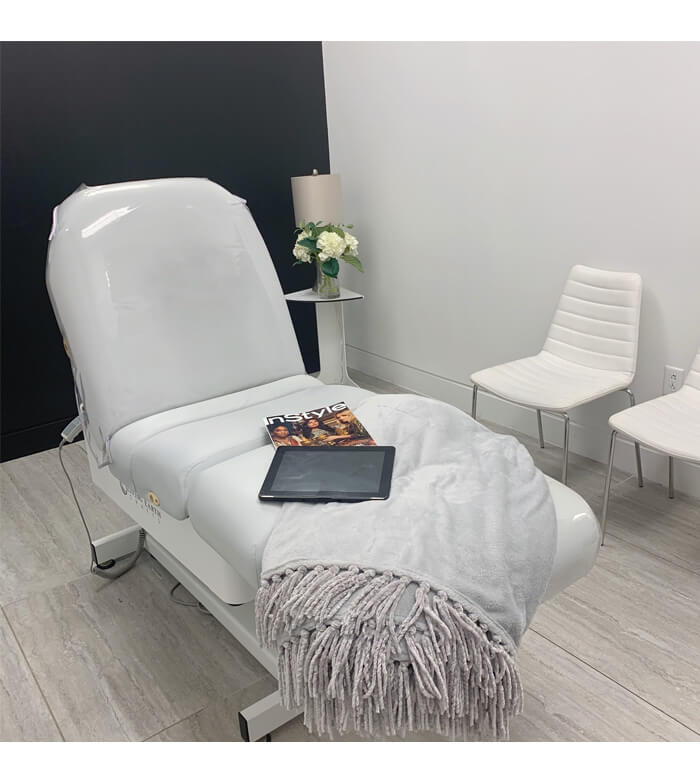Tummy Tuck
Abdominoplasty to Flatten a Bulging Belly
A tummy tuck—also known as an abdominoplasty or belly tuck—is one of the most corrective and rewarding procedures at Cross Medical Group. Patients who come to the Cross Medical Group office for a tummy tuck in the Philadelphia area often report years of frustration after having developed loose skin, abdominal muscle laxity, or both from pregnancy, childbirth, or weight fluctuations. They have been left with excess skin of poor quality that won't tighten despite attempts at weight loss.
Many patients describe a fullness to their belly that does not improve with sit-ups and core strengthening. This fullness often includes a ridge that patients can feel running down the center of their abdomen—a problem known as diastasis recti or rectus diastasis. The common theme for all of these patients is that these issues cannot be corrected at home with diet or exercise. They can, however, be corrected with a customized tummy tuck to address the areas in need of improvement.
What Does a Tummy Tuck Involve?
Successful results require a few key steps both before and after the tummy tuck:
Step One: A Customized Plan
This involves Dr. Kevin Cross and Dr. Jackie Lyons understanding a patient's goals and carefully examining their anatomy. Because there are many different ways of performing a tummy tuck, Dr. Cross and Dr. Lyons must ensure that each patient is partnered with the ideal technique based on where they're starting from and their desired results. Options include a "mini-tummy tuck," "short-scar" tummy tuck, and traditional tummy tuck. These procedures may or may not include the use of liposuction to sculpt excess volume. Muscle tightening may be necessary to achieve greatest flattening effect.
Step Two: Achieving a Natural-Looking Result
Poorly placed scars or an unnatural-looking belly button will undermine the effects of any tummy tuck. For the ultimate results to look natural, the incision that is used to remove extra skin—whether it is a short-scar incision or a traditional incision—should be low and well hidden under any pair of underpants, bathing suit bottom, or low-cut pants. In fact, Dr. Cross and Dr. Lyons allow patients to wear their favorite style underpants or bikini bottom on the day of the procedure so that they can make sure the tummy tuck incision is positioned within the region covered by the garment.
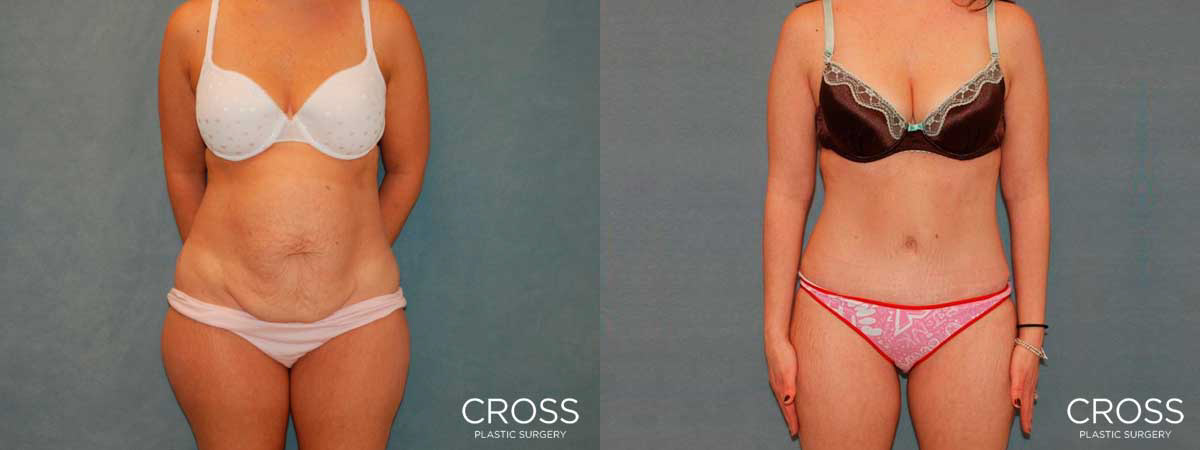
*Results May Vary
Before & After Photo Gallery
See for yourself the patient transformations that can be achieved by Dr. Cross, Dr. Lyons, and their team.
Step Three: A Beautiful-Looking Belly Button
The belly button must look natural and attractive, because when a patient is wearing underpants or a bathing suit bottom, the only incision in a traditional tummy tuck that could possibly be noticeable is the belly button. When a new belly button has to be made because excess skin around it is being removed, it has to look perfect. Dr. Cross and Dr. Lyons believe that a beautiful belly button should have no obvious scars and should not look simply like a round hole, but should have elegant shadows and contours that make it appear youthful and attractive.
Step Four: A Short Recovery
The recovery from a tummy tuck procedure should be as brief and as manageable as possible.
SCHEDULE A CONSULTATION
Schedule a consultation for a tummy tuck in Philadelphia by calling Dr. Kevin Cross or Dr. Jackie Lyons at Cross Medical Group at (215) 561-9100 (Philadelphia) or (610) 688-9100 (Villanova), or send a message online.
What Causes the Conditions a Tummy Tuck Addresses?
Skin Changes
Skin is comprised of many different cells and molecules. Two of the most important molecules that determine skin quality and firmness are collagen and elastin fibers. These fibers course through the second layer of the skin, called the dermis. The amount of collagen present in the skin, in part, determines the thickness of the skin, and the quality and amount of elastin fibers are responsible for the skin's ability to tighten.
Pregnancy or other forms of weight gain put stress on the collagen and elastin fibers, causing them to thin, weaken, and break. Some breaks are severe enough to cause areas of relative absence of collagen. These "super-thinned" dermal regions with intact overlying epidermis are known as "stretch marks."
Changes to the skin are often not reversible, even when the stress of pregnancy or weight gain is removed. The skin is left with poor-quality collagen that has been spread over a larger surface area, creating excessive skin that is thin and not as healthy.
Such changes can, however, be addressed by removing the unhealthy or loose skin during a tummy tuck. Additionally, any stretch mark at the level of the belly button or below can be removed along with the excess, and any stretch marks above the belly button can be lowered so that they are not as visible.
Muscle Changes
The muscles of the belly can experience the same stresses that stretch the skin. The tissue that holds muscles in place is called fascia. This tissue is stronger than skin, but it too can stretch in an irreversible way during pregnancy or weight gain. When the fascia between the rectus muscles (also known as the "six pack" muscles) widens, a ridge or separation (diastasis recti) can be felt between the muscles.
Because the muscles are no longer running next to each other on either side of the belly's center line, they function less effectively. This leads to the appearance of a bulge, even though the muscles themselves may be very strong. Since proper positioning of the rectus muscles helps to balance the pull from the muscles of the back, diastasis recti often significantly impacts core strength.
Thinning of the fascia can also lead to the presence of hernias, which are bulges through the fascia. This can occur throughout the abdomen, but most commonly happens in the belly button area. Some patients notice a significant fullness around their navel, while others notice that their belly button simply looks like an "outie."
Fat Changes
When adults gain or lose weight, they do not significantly add to or reduce the number of fat cells in specific areas. Rather, their fat cells grow or shrink. After pregnancy or fluctuations in weight, fatty tissue can collect in pockets. These fatty areas can be metabolically less active than other areas, which means the fat cells there are extremely resistant to diet and exercise—and much more difficult to shrink.
In fact, this problem is not limited to fat. Like the skin above, none of the changes that occur to the fat, fascia, or muscles can be improved by diet and exercise alone. By tightening the fascia, repositioning the muscles, and repairing hernias simultaneously, all elements of the belly are restored.
What Are the Tummy Tuck Procedure Steps?
The Skin-Only Tummy Tuck
Excess skin is addressed by removal. For many patients, this is all that is necessary to achieve a slimmer look. The technique is known as a "skin only" or "modified" tummy tuck and can be used to tighten loose skin and remove stretch marks located below the belly button, as well as all poor quality skin above and below the belly button.
For this tummy tuck procedure, Dr. Cross and Dr. Lyons lift the skin and pull it tight. Excess skin is tucked and removed through an incision that runs horizontally and below the underpants or bikini line. The advantages of a "skin only" tummy tuck include less discomfort during the recovery period because no muscle tightening is involved. For most patients, the muscle tightening is what causes most of their discomfort after the procedure. Also, liposuction can be used to do more contour correcting, when necessary, because not as much work is being done under the skin.
With this tummy tuck technique, patients are able to get back to exercise more quickly (generally in two to three weeks) and do not have any limitations on core work (planks, sit-ups, etc.).
The Short-Scar or Mini Tummy Tuck
The term "short-scar" or "mini" tummy tuck is generally used to describe procedures that make use of incisions that are hidden in the lower pubic region and that do not extend out to the hips. This procedure is a great option for patients who have poorly healed C-section scars, a shelf or roll of skin in the lower pubic area, and loose skin below and around the belly button. It is not as effective for patients with loose skin above the belly button.
Dr. Cross and Dr. Lyons can offer short-scar tummy tucks for patients who require muscle tightening, and they can effectively use liposuction in short-scar or mini tummy tuck procedures. They emphasize that the key to an effective short-scar or mini tummy tuck technique is in selecting the correct patient for the procedure.
Muscle Tightening and Fat Contouring
When muscle separation, muscle looseness, or diastasis recti is present, Dr. Cross and Dr. Lyons address the problem by repositioning the muscles. During this procedure, the muscles are not cut. Instead, muscle repositioning is performed by tightening the fascia that surrounds the muscles. At this time, hernias are repaired and bulges are reduced. When fatty pockets are present, they are sculpted with liposuction— which can be combined with a skin-only tummy tuck or with skin removal and muscle tightening.
The No-Drain Tummy Tuck
Dr. Cross and Dr. Lyons are now performing many of their tummy tucks using a "no drain" technique. Drains are small, clear tubes— pproximately the diameter of IV tubing—that connect to bulbs that look like clear avocados. Traditionally, drains are used to remove fluid that would otherwise collect under the skin during healing. Buildup of this fluid can hinder proper recovery. In appropriate patients, Dr. Cross and Dr. Lyons use an internal suturing technique that allow them to eliminate the space where fluid can accumulate, making drains unnecessary.
What Is Recovery Like After Tummy Tuck Surgery?
The key to a faint, discreet scar after a tummy tuck is avoiding tension on the closure. For this reason, Dr. Cross has developed his version of a closure technique known as eversion, also used by Dr. Lyons. It removes tension from the skin edge to prevent scar widening and thickening.
The recovery time for a tummy tuck is largely determined by the specific technique performed. For a "skin-only" tummy tuck, the recovery is limited by the skin tightness the patient feels after the procedure.
Traditionally, patients are told by their surgeon that they have to walk with a significant bend at the waist after tummy tuck surgery. The skin loosens over time, but this loosening often takes a week or more. Dr. Cross and Dr. Lyons are now completing tummy tuck surgery in a way that allows patients to walk almost completely upright right after their surgery. Patients wake up after the procedure wearing a garment that is very similar to a medical version of SPANX. The garment is removed after two days, at which point the patient can shower and wash over their body.
All sutures are dissolvable, and incisions have a watertight glue placed on them at the end of the procedure. There is often a moderate degree of discomfort along the incision for up to a week, but most patients are able to take very little pain medicine and are back to most of their normal activities— including driving—within a few days. Exercising can begin two weeks after the procedure.
If muscle tightening is performed during a tummy tuck, there is more discomfort in the belly region. In many cases, however, Dr. Cross and Dr. Lyons treat the muscle with a numbing medicine that lasts three days. This numbing has decreased their patients' discomfort by more than 50 percent. Patients who have muscle tightening will take a few more days to heal compared to the skin-only tummy tuck technique, but light exercising can begin around three weeks, full exercising (other than core work) at four weeks, and core exercises at six weeks.
More Body Contouring Options
Loose skin is not a problem restricted to the belly area. It can happen all over the body, especially in patients who have rapidly lost a significant amount of weight. There are many procedures that can remove excess skin like a tummy tuck or stomach tuck, each tailored to a specific area of the body: arm lift, thigh lift, buttock lift, lower body lift, face lift, and neck lift.
SCHEDULE A CONSULTATION
Searching for a "tummy tuck near me?" Contact Cross Medical Group for tummy tuck in Philadelphia (215) 561-9100 or Main Line's Villanova (610) 688-9100. You can also send a message online to inquire about a consultation, with Dr. Kevin Cross and Dr. Jackie Lyons, or for more information.



